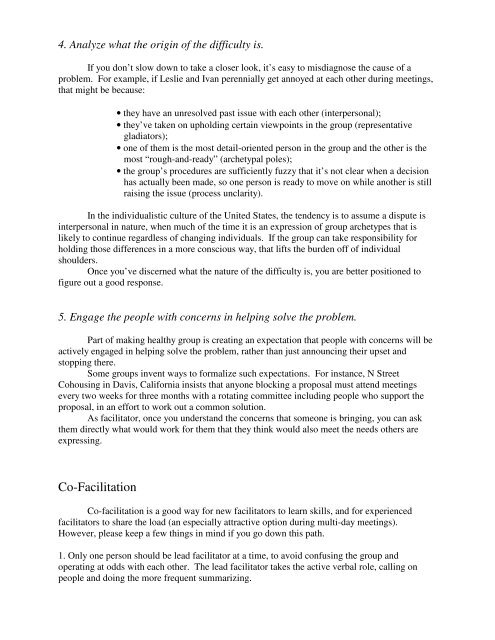GROUP FACILITATION PRIMER.pdf - Tree Bressen
GROUP FACILITATION PRIMER.pdf - Tree Bressen
GROUP FACILITATION PRIMER.pdf - Tree Bressen
Create successful ePaper yourself
Turn your PDF publications into a flip-book with our unique Google optimized e-Paper software.
4. Analyze what the origin of the difficulty is.<br />
If you don’t slow down to take a closer look, it’s easy to misdiagnose the cause of a<br />
problem. For example, if Leslie and Ivan perennially get annoyed at each other during meetings,<br />
that might be because:<br />
• they have an unresolved past issue with each other (interpersonal);<br />
• they’ve taken on upholding certain viewpoints in the group (representative<br />
gladiators);<br />
• one of them is the most detail-oriented person in the group and the other is the<br />
most “rough-and-ready” (archetypal poles);<br />
• the group’s procedures are sufficiently fuzzy that it’s not clear when a decision<br />
has actually been made, so one person is ready to move on while another is still<br />
raising the issue (process unclarity).<br />
In the individualistic culture of the United States, the tendency is to assume a dispute is<br />
interpersonal in nature, when much of the time it is an expression of group archetypes that is<br />
likely to continue regardless of changing individuals. If the group can take responsibility for<br />
holding those differences in a more conscious way, that lifts the burden off of individual<br />
shoulders.<br />
Once you’ve discerned what the nature of the difficulty is, you are better positioned to<br />
figure out a good response.<br />
5. Engage the people with concerns in helping solve the problem.<br />
Part of making healthy group is creating an expectation that people with concerns will be<br />
actively engaged in helping solve the problem, rather than just announcing their upset and<br />
stopping there.<br />
Some groups invent ways to formalize such expectations. For instance, N Street<br />
Cohousing in Davis, California insists that anyone blocking a proposal must attend meetings<br />
every two weeks for three months with a rotating committee including people who support the<br />
proposal, in an effort to work out a common solution.<br />
As facilitator, once you understand the concerns that someone is bringing, you can ask<br />
them directly what would work for them that they think would also meet the needs others are<br />
expressing.<br />
Co-Facilitation<br />
Co-facilitation is a good way for new facilitators to learn skills, and for experienced<br />
facilitators to share the load (an especially attractive option during multi-day meetings).<br />
However, please keep a few things in mind if you go down this path.<br />
1. Only one person should be lead facilitator at a time, to avoid confusing the group and<br />
operating at odds with each other. The lead facilitator takes the active verbal role, calling on<br />
people and doing the more frequent summarizing.


